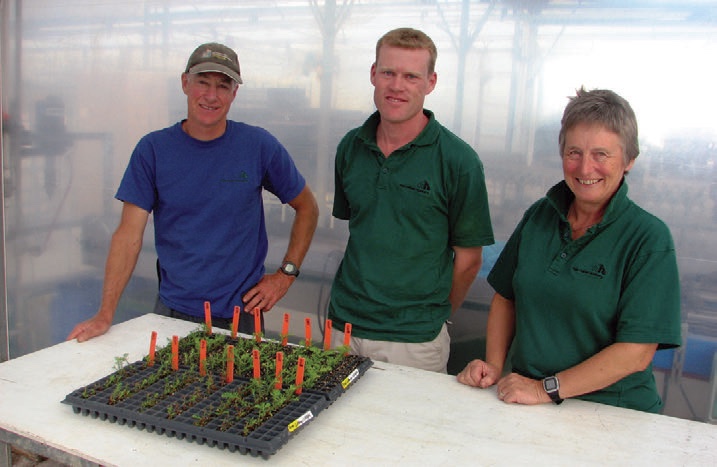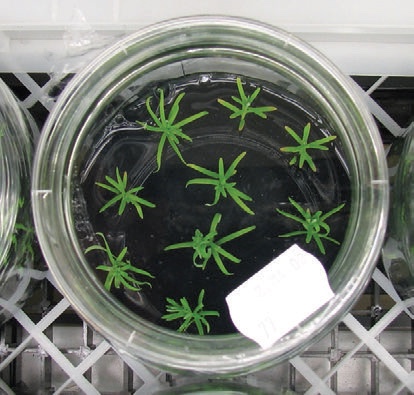Clonal redwood production
Greg Palmer and Simon Rapley, New Zealand Tree Grower May 2012.
The New Zealand Redwood Company tree sales programme is an alliance with Nga Rakau Nurseries Ltd. The New Zealand Redwood Company is a wholly owned subsidiary of Soper Wheeler Company of California and was founded to purchase hill country farms in New Zealand and establish redwood forest for future log production.
When planting began in 2002, good quality redwood tree stocks were hard to find so the best option seemed to be to produce our own trees. Seed and clonal material purchased from another redwood grower in California were imported and nursery production began. As most production systems are more efficient with larger scale, it was a logical step to grow more trees and offer them for sale.
The New Zealand Redwood Company tree sales programme is an alliance with Nga Rakau Nurseries Ltd. The New Zealand Redwood Company is a wholly owned subsidiary of Soper Wheeler Company of California and was founded to purchase hill country farms in New Zealand and establish redwood forest for future log production.
Nga Rakau is a third generation family owned business which has been operating since the early 1930s, originally growing pip and stone fruit, shelter, hedging and farm forestry species. Today Nga Rakau is a high tech nursery growing around 80 million plants each year including vegetables, bedding plants, native trees and forestry lines. Production at Nga Rakau is based around growing in cell trays better known as containers.
Growing in containers enables us to employ a rolling bench system and a level of automation whereby we can produce large quantities very efficiently. Nga Rakau employ an automatic greenhouse system which plays a vital part in nurturing tissue culture plantlets through to a hardened plant able to survive in the forest, even in Canterbury.

Mark Struthers is the owner of Nga Rakau and is actively involved in the running of the nursery. Mark has recently purchased a farm and planted it in redwood and native plants. Greg Palmer is the production manager and Jan Velvin is an independent horticultural nursery consultant and who has been engaged by Nga Rakau to oversee parts of the propagation process.
Containerised stock
Container grown trees are very hardy as they do not suffer transplant shock as much as bare root stock. This means the planting season can easily be extended past the traditional winter months. We often have requests from growers wanting to plant trees through to November and we know that the timing will not cause problems.
We have known planting contractors to show a reluctance to work with containerised stock when they first encounter them as they are heavier than bare root stock. However, the issue of weight becomes insignificant when the planters see how much easier they are to plant.
Tissue culture propagation
Tissue culture is a vegetative propagation system in which plant tissue is taken from a desirable parent plant and multiplied on demand. It can be thought of as miniature cutting propagation. The new tissue is carefully decontaminated and placed in a petri dish containing a sterile growing medium such as agar. The plantlets produced have no cuticle and often have no roots and are therefore very susceptible to disease and desiccation when first taken out of the sterile environment. As a result, losses can be very high.

If it sounds like a complicated way to grow trees, that is because it is. However, there are distinct advantages, which is why we continue to use tissue culture production.
First, we can produce large numbers of plants relatively quickly. In one season, we required 350,000 trees for our own planting as well as orders for a further 350,000. Producing such large numbers of trees by any other propagation method would be difficult.
Secondly, we are able to hold the genetic material in a state where it does not appear to age physiologically. Many plants, and most conifers, undergo a change as they grow older in the forest or in nursery stool beds. The form of the tree and some of its metabolic processes are altered due to changes in growth regulators in the cells of the tree. Aged cuttings lose vigour and become more difficult to root and we have chosen to avoid these problems with tissue culture propagation.
Finally, tissue culture allows us to get improved genetics into the forest quickly. Mature redwood trees with known characteristics can be copied and multiplied in three to four years, a trait rare among conifers. The trick is finding trees that meet all of the requirements.
Cultivars under production
The cultivars we plant on our own land and those we offer for sale are chosen for ease of propagation, rapid growth and good stem form but have also met minimum standards for wood properties. Heartwood colour must be average or darker than average, the basic density of the parent tree must have been over 320 kg a cubic metre and shrinkage of the wood must be very low.
We know that the market prefers darker coloured wood, and studies in California and New Zealand show a strong relationship between colour and durability with darker heartwood having better natural durability. Density is a broad indicator of wood quality and we are aiming to remove low and very high density genotypes from production. Good dimensional stability is one of the key characteristics of redwood. Fortunately, virtually all New Zealand grown redwood has superior stability to California grown young- growth and even old-growth redwood.
We have established clonal trials each year over a range of sites from cool and dry in the South Island to warm and wet in the North Island and even have trials in California.
Challenges for the future
Redwood trees are difficult to produce, whether from seed, cuttings or tissue culture and we are working hard to improve our system and reduce the cost of the trees we plant ourselves and sell. We also need to be continually bringing new cultivars into production and so far we find only 10 per cent of selections meet all of our requirements.
We do have some promising material under evaluation and hope to continually expand and improve the collection. Together NZRC and Nga Rakau are looking forward to taking on these challenges and continue to produce the quality redwood tree stocks for growers in New Zealand.

 Farm Forestry New Zealand
Farm Forestry New Zealand

